|
|
|||||
| home > architetture | |||||
| MORPHOSIS.
NYC2012 Olympic Village |
|||||
| In
September 2003, NYC2012 -the committee leading New York's bid to become
the host city of the 2012 Olympic Games- invited all architects to participate
in an Innovative Design Study to envision the Olympic Village for New
York City's 2012 Olympic Bid. The Design Study was led by NYC2012's
Director of Planning, Design and Development Alexander Garvin who, as
former Vice President of the Lower Manhattan Development Corporation
(LMDC), already had a very significant experience selecting the designer
for the World Trade Center site from a wide array of submissions from
some of the world's leading architects. The first phase of the NYC2012's
Olympic Village Design Study was launched with the issuance of an RFQ
(Request for Qualifications) with deadline in November 2003. The eight-member
Design Review Panel evaluated and assessed more than 130 submissions
from 20 countries. Following the RFQ, five finalists were selected, representing a wide range of urban and architectural design philosophies, and invited to participate in a 15-week planning and design study that began in mid-December 2003 and concluded in March 2004. Among the five finalists were: Morphosis (Santa Monica, CA), Henning Larsens Tegnestue A/S (Copenhagen, Denmark), MVRDV (Rotterdam, The Netherlands), Smith-Miller + Hawkinson Architects (New York, NY) and 2004 Pritzker Prize winner Zaha Hadid Architects (London, United Kingdom). The results of the design process and five finalists were presented to NYC2012 and to the public through an exhibition in Grand Central Terminal's Vanderbilt Hall and an interactive website so as to promote an international, free-flowing exchange of ideas as well as encourage an evaluation a public comment period. Concurrently, NYC2012 staff conducted various studies necessary to assess the viability of the plans. On May 26, 2004 Morphosis was announced as the winner of NYC2012's Olympic Village Design Study. An Advisory Committee, comprised of Olympians and Paralympians and Olympic and Paralympic Games operations experts, was set up by NYC2012 to review the finalist plans. The Committee made recommendations for various aspects of the Village in order to ensure that the best athlete experience be provided. The proposed New York City Olympic Village site is located in Queens West, on a large waterfront property directly across the East River from the United Nations. Morphosis' winning design features a long, sinuous ribbon of primarily low-rise buildings that skirt the waterfront and allow spectacular views of the Manhattan skyline. The Morphosis plan minimizes building footprints (80% open space) and thus allows the compact 52-acre site to be transformed into a broad city park. Morphosis positions most of the structures along the water close to the western edge of the site. The two transportation hubs -for dedicated Olympic trains or ferries- are conveniently located within a five-minute walk or two-minute shuttle ride from the farthest athlete apartment, thus ensuring easy access for the athletes to all of New York City's cultural and entertainment attractions. The park-like setting allows for the integration of indoor and outdoor training facilities (including several multi-sport fields, a full size Olympic track around a soccer pitch, tennis courts, and various smaller fields ideal for personalized workouts, several gymnasiums, an Olympic swimming pool, exercise and fitness areas, locker room with saunas) adjacent to the residential zone of the Village. Entertainment areas include: 4 theater cinema, marina with waterfront area, 'natural' amphitheater in the urban green, strolling parks, athletic center and fields, the beach with volleyball courts. Also, as far as smaller amenities, Morphosis also planned on a retail area which may include shopping, internet cafes, arcade or game rooms, etc. The Village, financed and constructed by private developers selected by the Queens West Development Corporation in consultation with NYC2012, will be rented by NYC2012 for the Olympic and Paralympic Games of 2012 and house 16,000 athletes and coaches; following the event, it will be returned to the developers and provide world class residential housing for up to 18,000 New Yorkers in the city's newest waterfront community. ARCH'IT presents here Morphosis winning proposal for the NYC2012 Olympic Village Design Study. Paola Giaconia |
|||||
Expressing
a vision of global unity amidst the highest levels of human performance,
the Olympics takes its place among the institutions created by our culture
to promote peace, tolerance, and humanitarianism. The NYC2012 Olympic
Village has an important symbolic role to play in public life both during
the Olympics and in its incarnation afterwards. The Village will redefine
the heart of the area by instilling values of diversity and cooperation
that engender optimism, civic mindedness and civic pride that will resonate
long after the Olympics Games are over. Aerial view. URBAN ORGANIZATION. Our design for the Village proposes an iconic landmark and an innovative vision for a 21st -century urban environment that will lead to a redefinition of contemporary urban living. Informed by a commitment to sustainability, connectivity and interdependence, it is our intent to transform Hunter's Point into a revitalized new community that will be a gift to the city while also providing a new generative tissue, or architectural DNA, that will function as a stimulus for creative development of the adjacent urban areas for years to come. With 43-acres of open space, this development's parklands will be the largest urban waterfront park in the 5-borough area. In addition to providing this area of Queens with a distinctive identity and a strong termination to the Queens West Development Corporation's (QWDC) Master Plan, it is our hope that this new community stimulates a sense of increased connectivity and interdependence within the greater five borough area. By working deliberately to sculpt land and building forms into a coherent relationship with the existing urban fabric and by responding to the naturally advantageous site conditions, we can create a vibrant new community that will function as a stimulus for creative and optimistic development of the adjacent urban areas for years to come. |
[27aug2004] | ||||
| Our
scheme proposes a multi-layered, three-dimensional urban organization
that prioritizes open space and emphasizes the symbiotic interaction
between water, landscape, building and program. Density and height are
intensified at the northern edge of the site to forge continuity with
the greater Queens West Development Corporation's (QWDC) Master Plan
while the careful, integrative shaping of built and land forms creates
a gradual transition into the Village's more moderately scaled residential
zone and parklands located on the southern portion of the site. During
the Olympics, the more densely developed area of the Village will accommodate
all International Zone functions and activities in a secure and contained
environment that is visually and physically discrete from the primary
residential zone and parklands. After the Olympics, this area will become
a mixed-use commercial/entertainment zone, providing the surrounding
community with amenities such as theaters, a fitness center, and grocery
store. |
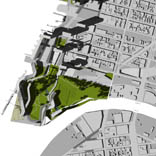 Site plan. |
||||
 Aerial perspective. |
 In an effort to repair the site's northeastern edge and strengthen the new development's physical and symbolic connection to the surrounding community, our scheme incorporates a Police and Fire Station that provide essential civic services to the neighborhood. Placed astride the Long Island Railway lines, the architecture of these buildings extends over the rail lines with a canopy that seamlessly merges into the development's renovated rail terminal and residential tower. A pedestrian bridge that ties directly into Jackson and Vernon Avenues, and a strategically located pocket park that serves as a punctuating terminus to Jackson Avenue, provide additional links and an invitation to the new development's broad offerings. |
||||
| RESIDENTIAL
COMMUNITY. The residential component of our scheme employs an iconic
formal strategy that substantiates our vision for an Olympic Village
that emphatically communicates the universal ideals of community, cooperation
and peaceful coexistence. Strategically positioned to prioritize and
knit together the open space and provide access to views of the city,
our design proposes a dense, undulating ribbon-like structure that gracefully
wraps around the edges of the site. The ribbon structure, together with
the residential towers that anchor it's northern end, will be visually
rich and porous, depicting a connective tissue that will be a powerful
symbol of the Olympic Games and the beneficial impact that they had
on the city long after the games are over. The orientation and articulation of the buildings emerge as a direct response to solar and wind patterns as well as to the remarkable views afforded from the site. Performing on both a functional and symbolic level, the ribbon structure embraces the site creating a ‘protected' park that is shielded from strong winds coming off the East River. The ribbon buildings are canted 14 degrees to optimize solar access into the park and residential units. In order to accentuate the sense of openness and connectivity that characterizes our design for the Olympic Village, 80% of the waterfront structure is elevated an average of four stories above grade creating broad portals that provide increased access to the waterfront. Towers and ribbon structure alike feature strategically placed sky gardens that further finesse the buildings' forms and provide increased access to light and views. |
|||||
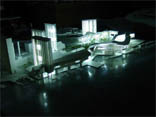 View of the model. |
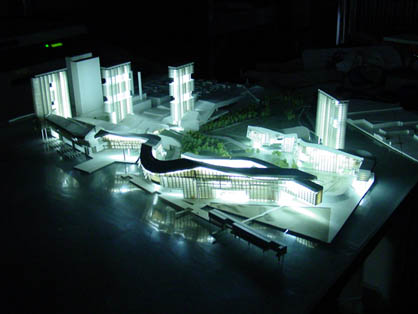 Collectively, the residential component of the Olympic Village will accommodate 16,000 athletes in 4,500 units for the duration of the Olympic Games and 18,000 residents in a wide selection of unit types thereafter. Designed to maximize access to sunlight and natural ventilation, over 50% of the units are through-units with views of both the city and the Village parklands. Nearly every unit has a view of at least one of these sights. The multi-story ribbon structure uses innovative skip-stop elevators -elevators that stop at every third floor- allowing for a higher density within the building envelope than is achievable with a standard double-loaded corridor. As an additional social benefit both during and after the Olympics, this configuration promotes foot travel and social interaction throughout the building. |
||||
| PARKLANDS.
Through their evolution over the last century, the Olympic Games have
established a strong tradition of leaving an identifiable and lasting
mark upon the cities in which they take place. Our design for the NYC
2012 Olympic Village advances this tradition by prioritizing open space
as a first principle and bequeathing upon the city 43-acres of parklands
that, if realized, will rank as the largest urban waterfront park in
the 5-borough area. Weaving through, around and under buildings, the
parkland is divided into six distinct zones: The Promenade, The Beach,
The Marina, The Urban Green, The Fields, The Plaza and the Wetland. THE PROMENADE. Designed to provide an accessible, rich and inclusive urban waterfront destination, the Promenade creates an armature that encourages pedestrian connections along the entire length of the East River. The Promenade, while extending and providing a connection to the QWDC's prominent esplanade, also serves as the element that connects the variety of residential, commercial and recreational uses into one cohesive whole. A distinct moment along the promenade is the 1100'-foot long pier extending out into the East River, which will host a selection of high quality restaurants offering dramatic views of Manhattan and promises to become one of the Village's prime destinations. THE BEACH. The 3-acre sandy beach buffered by a natural dune complex will punctuate the site's southern edge and serve as a gathering place for those strolling along the promenade. This new beach will be a one-of-a-kind urban amenity offering unprecedented views to Manhattan and opportunities for waterfront recreation. THE MARINA. At the northern end of the site, the new marina will serve the community with aquatic recreational opportunities. Strategically located adjacent to a café and cinema center, the marina promises to become a key destination point that makes connections to the existing neighborhood, adjacent ferry landing and the Village's Olympic Plaza. 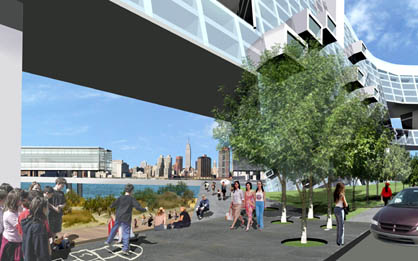 THE URBAN GREEN. The central and more "Arcadian" zone of the park features three distinct elements: an urban forest, the open lawn and the landscape berm, all spaces for informal gathering. The open lawn will primarily be used for casual recreation. Its southern end connects with the Village Stairs, which, like the Spanish Steps in Rome, provide a venue for social interaction. From the steps one can access the beach and the wetland along Newtown Creek. THE FIELDS. Situated on the site's easternmost half, this active zone of the park features numerous sports fields bounded by a cascading water feature and wetland estuary. Where the Urban Green acts as the social canvas for a whole host of events, the active zone is for athletic play and recreation. These fields can serve as local fields for community intramurals and sporting clubs. 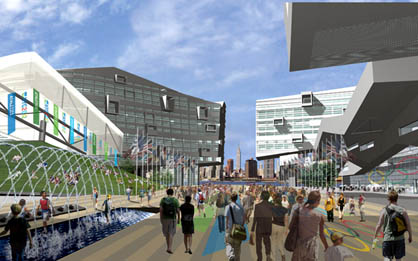 THE PLAZA. Establishing a prime view corridor from the Olympic Village to Manhattan's Empire State Building and the United Nations, the Olympic Plaza is designed to function as a grand public gathering space both during and after the Olympic Games. The 250 meter long plaza will leave an indelible mark of Olympic ideals upon the city while demarcating a clear transition between the site's two distinct zones. Extending from the Long Island Rail Road terminal past the bus station and to the water's edge, where the New York Waterways ferry will have a prominent new landing, the plaza also serves as the tissue that links together the community's multi-nodal transportation system. Post-Olympics, the plaza will provide the local community with a central place for informal and formal civic and cultural gatherings such as ethnic fairs, concerts, and farmer's markets. 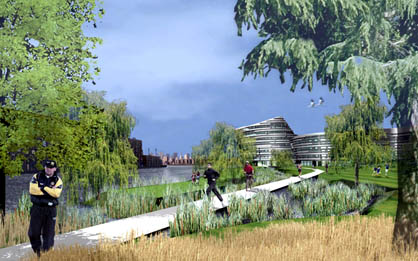 THE WETLAND. The tidal garden and wetland estuary will act as nodes to gather and collect surface and storm water run-off from rooftops and hardscaped areas. These areas will act as lungs or filters, removing any toxins and chemicals before the water is released into both Newtown Creek and the East River. This filtering process will be done through a series of stepped pools, which reintroduce oxygen into the water and wetland grasses, which digest harmful nutrient. These wetlands will also act as micro-climates for native birds, water fowl, and amphibious animals. INTEGRATING SUSTAINABLE DESIGN. The ongoing challenges to the management of resources demand that developers, planners and architects embrace their position as stewards of the environment to confront the ethics of ecology and the politics of energy by proposing economically, environmentally and socially sustainable alternatives to the growth of cities and the lifestyles of those who inhabit them. Our scheme for the NYC2012 Olympic Village responds to this challenge with a vision of a community that functions as a "living machine" by incorporating a range of low energy, high environmental quality planning and design initiatives and ecologically responsive landscapes that contribute to the conservation of the environment through the intelligent utilization of resources. Ours is a holistic design approach that will strive to attain the highest possible level of sustainability by capitalizing on the following key strategies: - TACTICAL, CONSCIENTIOUS SITE PLANNING AND DESIGN that optimizes massing and orientation of buildings to maximize opportunities for passive heating, cooling and ventilation and increased exposure to natural light in interior environments; - ON-SITE POWER GENERATION that renders the entire development independent from the power grid through employment of a combination of clean and/or renewable energy sources including a natural gas fired central cogeneration plant. Solar and wind energy will be collected where possible through incorporation of strategically located photovoltaics and wind turbines throughout the project. Excess energy will be stored for future use, returned back to the grid or made available for purchase to outside entities. Surplus heat and cool air produced by the cogeneration plant will also be recycled for use within the development and/or made available as a resource for the surrounding neighborhood; - OPTIMIZED WATER MANAGEMENT will be achieved through inclusion of an extensive greywater recycling program that will reuse waste water from the site for irrigation of the park and greenspaces. Stormwater run-off from the development will be diverted through a series of cascading aeration pools and wetlands that are designed to supply a continuous flow of clean water into Newtown Creek and the East River. Low water consuming fixtures will be specified throughout the project to further increase efficient use of water on site; - OPTIMIZED WASTE MANAGEMENT will be achieved through all phases of development through issuance of a set of "green" specifications that will mandate compliance with a strict qualitative and quantitative waste management initiative during construction. Furthermore, every building on site will be furnished with conveniently located recycling stations that will facilitate and encourage occupant/user participation in a development wide recycling program. We are also proposing that lease agreements on the properties include a set of recycling guidelines that must be adhered to for tenancy; - A CARBON NEUTRAL DEVELOPMENT will be achieved by maximizing use of low carbon emitting materials throughout the project. In order to realize a zero net carbon effect, we are proposing a ‘future forest' concept that will offset on-site carbon emissions through purchase of land on which a sufficient number of trees will be planted to compensate for the carbon emissions that this development delivers into the environment; - MAXIMUM USE OF RECYCLED AND RENEWABLE MATERIALS throughout the development will further ensure high levels of environmental responsiveness. These materials will include a wide variety of recycled wood, glass, and plastics that can be used in rough and finish construction. During manufacture, Portland cement is associated with very high levels of greenhouse gas emissions. The final specifications for this project will establish a high percentage replacement of the cement with granulated blast furnace slag, a recycled waste product that is readily available in the region. mOrphosis |
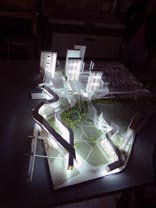 View of the model. |
||||
| MORPHOSIS.
NYC2012 Olympic Village |
|||||
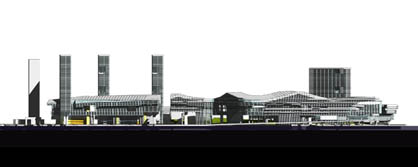 architect: Morphosis principal: Thom Mayne project manager: Paul Gonzales design team: Graham Ferrier, Ed Hatcher, Nadine Quirmbach, Chris Warren technical production: Reinhard Schmoelzer with Luis Luz, Masako Saito, Go-Woon Seo project assistant: Natalia Traverso research and writing strategist: Anne Marie Burke landscape architect: Hargreaves Associates principal: George Hargreaves project manager: Brennan Cox associate architect: Gruzen Samton, LLP principal: Jordan Gruzen MEP Consultant: IBE Consulting Engineers principal: John Gautrey project engineer: Peter Simmonds transportation consultant: Arup Engineers principal: Greg Hodkinson planning consultant: Richard Weinstein cost consultant: Davis, Langdon, Adamson associate principal: Ethan Burrows data: total site area: 52 acres area of park: 43 acres beach: 3 acres playing fields: 15.75 acres urban green: 9 acres wetland: 3 acres olympic plaza: 2.5 acres marina: 1.25 acres boardwalk: 5.5 acres corner parks: 2 acres pier: 0.5 acres |
|||||
|
Per
candidare progetti laboratorio
|
|||||